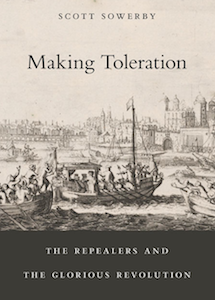Short-listed for the 2014 Phi Beta Kappa Ralph Waldo Emerson Award
By Sarah Gustafson
There is an understated bravery about Scott Sowerby’s debut monograph, Making Toleration: The Repealers and the Glorious Revolution. He ushers the reader through a powerful re-reading of one of English history’s defining moments: the fall of the Catholic Stuart King James II and the establishment of William and Mary as heads of a re-envisioned constitutional monarchy. In researching the little-known Repealer Movement, Sowerby transforms the traditional “Glorious Revolution” narrative of Catholic villains and Anglican heroes into a struggle of wills and principles between a tolerant and liberal “absolutist” king and a staunchly Anglican, and thus conservative, English Parliament.
As a scholar of modern France, I was unfamiliar with many of the factual details and various historical interpretations of the events of 1689. Sowerby’s Introduction, and extended discussion of “Thermodynamic” model Revolution, serves well to situate readers and clarify his historiographical contribution. This familiar model of revolution typically sets an aggrieved, reform-minded, liberty-seeking movement of the people against an intractable, conservative State countermovement. Sowerby admits that James II, as a Stuart and Catholic king of an overwhelmingly Protestant nation, easily fits the part of oppressive absolutist monarch. Therefore, his opposition – the Anglican majority – easily assumes the heroic role associated with movements of liberalism and freedom. In the annals of history, the “hardly conservative [religious and political] policies” of Parliament under William and Mary, notably the 1689 Act of Toleration and the Declaration of Rights of 1689, seems to bolster that narrative.
Thanks to what the Repealer Movement reveals of James II’s kingship, that narrative is fundamentally undermined. This brand new research permits Sowerby to present a radically new vision of the Stuart king: that of a visionary whose ideal of religious toleration meant a repeal of the discriminatory Test Acts of 1673 and 1678 and “a universal grant of toleration for all English people, which he sought to be made irrevocable by an act of Parliament.” The Repealer Movement, a loose coalition of non-conformers in London as well as the country, embodied what Sowerby calls James II’s “transformational politics.” Familiarizing Englishmen with the issue of toleration in the hopes of amassing popular support for the repeal, the movement had a radical mandate and a radical – who happened to be Head of State – at the head. The first movement in this revolution was not “the oppositional movement that overthrew the king… It was, instead, a movement for reform sponsored by the King.” This James II, embracing “liberty of conscience [as] a fundamental right of all English subjects” and doing so in direct appeals to the people, hardly corresponds to that in the traditional narrative.
Creatively analyzing a variety of sources, in nine chapters Sowerby brings us from the conception of the Repealer Movement in 1687 to the Glorious Revolution in 1689 and the Act of Toleration eighteen months later. He details the diverse players involved (metropolitan, rural, clerical and popular), as well as those successes, challenges, fears, and shortcomings that ultimately doomed the campaign for universal toleration and its king. Though he seems to admire James II and his coalition-building skills, he does not hesitate to critique James for dismissing anti-popery, the dominant unifying force – “a large scale, intractable problem” – without which the invasion of William of Orange and the Glorious Revolution would not have been possible or successful. Sowerby concludes, however, that any more moderate governance James II would not necessarily have avoided the Revolution: “Governing moderately would not have put to rest the anti-popish fears.” Rather, he insists that the Stuart monarch was “an anomaly,” preferring to “back causes,” and “[tie] his fate to those causes” than to play the shrewd and retiring monarch seeking public approval.
In the end, the Glorious Revolution strengthened an anti-popish status quo; what then to make of the Repealer Movement’s contribution? Sowerby’s answer has implications for multiple fields of study. With regard to interpreting English history, the Repealer Movement failed yet it introduced questions of religious liberty in new ways and formed new groups out of previously-disconnected non-conformers. That lobby then extracted itself new rights in a new Act of Toleration. On the side of political theory, Sowerby proposes that the rise of modern constitutionalism is a phenomenon of many origins; not only can the popular will act to limit a ruler, as in the traditional narrative, but “minorities [such as the non-conformers can organize] themselves to repel the overbearing demands of majorities… circumscribing the capacity of their enemies to act against them.” Lastly, the answer has implications for the relationship between History and politics, and ways political cultures are built through historical memory. Provided that non-conforming Protestants forget their collaboration with Papists and James II on repeal, the Anglican majority accepted non-conformers into the mainstream – thus “tabling” any more radical extensions of religious liberty. The Repealer Movement forgotten, James II rendered a villain, a new consensus was built on the foundation of “a lapse of memory…” Sowerby’s approachable yet profound work deserves its multiple accolades for recovering to History part of how the traditional history of the Glorious Revolution came to be.
Sarah Gustafson (ΦBK, Davidson College, 2014) is a candidate for the master’s degree in the History of Political Thought and Intellectual History at University College London, and looks forward to her future pursuit of a Ph.D. in European History.




